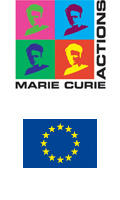Nanowires for energy harvesting
This work package aims at exploring the performance of semiconductor NWs as energy generators: for increasing the efficiency of photovoltaic cells and, at a much smaller scale, for self-powering nanodevices, such as sensors, nanoelectronic devices or robots, by harvesting heat or mechanical energy waste from the environment. Thus the work package will be structured into three different subtopics regarding three different applications: photovoltaic, thermoelectric, and piezotronic (based on piezoelectric generation) devices. Nine different teams with complementary capabilities will be involved in the proposed activities.
Photovoltaic cells
Two different solar cell concepts will be explored within this subsection: the first one based on p-n junctions in the form of core/shell NWs; and a second approach where semiconductor NWs will be sensitised with II-VI quantum dots and organic molecules.
Core/shell NW-based cells using different materials (Si, InGaN, and ZnO) will be investigated. The work on Si NW solar cells will focus on removing the SiO2 layer that forms on Si NWs grown on ITO and achieving effective p- and n-doping. In order to implement InGaN NW-based photovoltaic cells three major problems should be overcome: the homogeneous incorporation of Indium in high concentrations to match the whole solar spectrum; the production of high quality core/shell NWs on a transparent conductive substrate; the achievement of p-doped material. ZnO will also be exploited for core/shell NW solar cells by covering n-ZnO with a p-type organic polymer.
The light-to-current conversion efficiency in DSCs based on ZnO NWs will be investigated experimentally and theoretically in order to understand the mechanisms that lead to photocurrent generation; this will allow us to design material with desired physical properties. The efficiency of different anchoring groups in attaching to the ZnO surface and new functionalisation schemes for this material will be explored. Different functional groups and several classes of efficient harvesting systems (both organic molecules and inorganic nanoparticles) will be designed by combining theoretical and experimental effort of the Units involved in the projects.
Thermoelectric devices
The main objective of this work package will be to reduce the thermal conductivity of SiC NWs by modifying their surfaces without disrupting the electron transport through the NW core and, in this way, enhance the thermoelectric figure of merit. Thermal properties of SiC are expected to improve those of Si and, on the other hand, attaching molecular ligands to the NW surface will affect the phonon conductivity of the surface. Theoretical calculations will be performed simultaneously in order to complement the experimental results.
The device proof-of-concept should be carried out by studying single NWs with different diameters and surface modifications. A Visiting Researcher from a leading group in this field will assist to the measurements of the thermal conductivity of a single NW. Compact arrays of SiC NWs will be also prepared for macroscopic thermal conductance measurements and potential device implementation.
Piezotronic devices
Electrical generation by mechanically deforming piezoelectric (ZnO and SiC) NWs will be explored as a proof-of-concept for future piezotronic devices. These studies will complement those carried out in WP1 concerning piezoelectric sensors. The first objective will be to systematically study the piezoelectric voltage generated by externally straining a single NW. The inhomogeneous strain distribution within the NW will be calculated theoretically to improve the interpretation of the experimental results. Compact ordered arrays of NWs will be also grown in order to scale up the concept to a macroscopic device.

